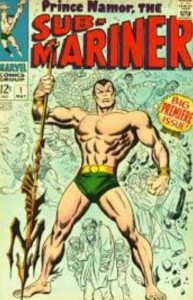Alpha and Omega: First and Last
Is Marvel crazy? Have they overlooked one of their oldest, most popular characters among all those they have introduced into the MCU movie universe? Where is Namor also known as Sub-Mariner? Technically, Namor might be the FIRST Marvel Comics hero. In his appearance in Marvel Comics #1 in 1939, the comic that ushered in the Marvel Universe, the Bill Everett story and art was actually a reprint from Motion Pictures Funnies Weekly. It was a black and white newsprint throw away comic given free with the admission to the movie theater. This original predates Marvel Comics #1 by six months. Yet, Namor has moved to the back of the line. The LAST story to be told. IF his story EVER gets told.
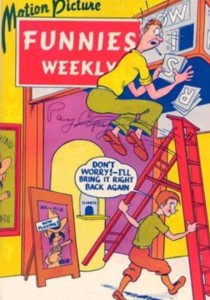
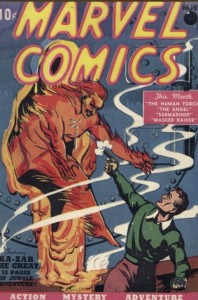
Misunderstood Rebel WITH a Causel
Namor’s story, these days might actually appeal to liberals. He was a half-breed, shunned initially by both races, the son of a deep ocean native warrior princess, who had to fight his way to the throne. There he fought climate, pollution, ocean animal killers, modern weapons of war and his every heroic deed was mischaracterized as evil. So what’s the hold up getting him to the big screen? Corporate greed? Capitolism? Conservative’s agenda. Something more dramatic. He’s owned by two different Hollywood Studios. As one of the characters “shopped out” during Marvel’s bankruptcy 1999 B.D. (Before Disney) Marvel sold the movie rights of X-Men to Fox, the Fantastic Four to Columbia/Sony, and Hulk and Namor to Universal. Now Namor the half-bred human and Atlantean Merman is truly got half his body at Universal Studios and half at Marvel Studios. Just enough rights are owned by both to keep Namor off the screen for many more years.
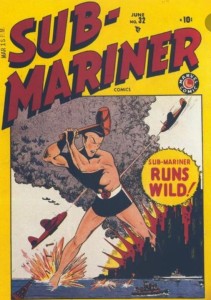
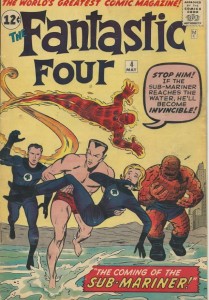
Hero to Villain: There and Back Again
Sub-Mariner (pronounced “sub-MAH-rain-er”) has had a roller-coaster career of good guy, bad guy, good guy again. After all what do you expect from a social outcast? The love child between a human sea captain and the beautiful (and blue) royal warrior princess mermaid people who are the remnant of the lost city of Atlantis. Namor gets his Caucasian color and handsome rugged features from his human father and his pointy ears, gills and winged ankles (they look like wings but are actually webbed flippers propelling him faster in the water) from his mother, Fen. Raised by her in the depths of the ocean in the kingdom of Atlantis, he was groomed for the throne, but literally lost it. Being raised in the great depths of the ocean under such water pressure gives him great super strength when standing on the surface, where he can breathe air, due to his dual biological nature. During World War Two, Namor watched surface men attack one another sinking great ships, airplanes and submarines (different pronunciation) into his ocean home, including bombs, radioactive material, garbage and various human pollutants. Kind of ticks a guy off. Fortunately, he teamed his wrath against the axis powers aiding Captain America, Whizzer, The Android Human Torch and others to battle the Germans and Japanese with the All-Winners Squad. That alliance ended with the war. By 1954 all of Marvel’s superhero comics had faded into oblivion. Marvel’s first hero was also the first to lose his own title. Then, in 1962 in the beginning of what was later to be known as the Silver Age of Comics, Namor was the first of the WWII heroes to be revived. Marvel and DC comics were in the beginning of a great revival of superheroes. DC had a bit of luck bringing back the Golden Age Flash, so Marvel was eager to see how fans would react to their old heroes. Marvel had introduced their first title in November 1961: The Fantastic Four. It was a hit. So in the fourth issue of that series in early 1962 Namor re-emerged, and this time as an opponent.
Golden Hero; Silver Age Villain
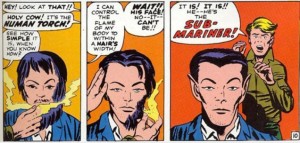 To explain away 18 years of Namor’s dormant activity the Stan Lee and Jack Kirby story made him a transient living in men’s shelters in New York, living on the streets. He had grown a full mane of dark hair covering his pointy ears, and a long beard and mustache. He had no memory of who he was. That is until a meddling Human Tourch thought he recognized him from a stack of old comic books he was reading. Johnny Storm burned off Namor’s beard and hair exposing him for who he was. A defensive battle began and being close to the docks they ended up in the water where Namor’s gill’s drew in sea water and his mind cleared. Namor’s first act was to search for his kingdom. Finding it destroyed and his people missing, he declared war on all surface dwellers. Soon, Namor was in a full on battle with all four of the FF. they drove him back into the ocean. Not before Namor was smitten with the beauty of the invisible girl, Sue Storm.
To explain away 18 years of Namor’s dormant activity the Stan Lee and Jack Kirby story made him a transient living in men’s shelters in New York, living on the streets. He had grown a full mane of dark hair covering his pointy ears, and a long beard and mustache. He had no memory of who he was. That is until a meddling Human Tourch thought he recognized him from a stack of old comic books he was reading. Johnny Storm burned off Namor’s beard and hair exposing him for who he was. A defensive battle began and being close to the docks they ended up in the water where Namor’s gill’s drew in sea water and his mind cleared. Namor’s first act was to search for his kingdom. Finding it destroyed and his people missing, he declared war on all surface dwellers. Soon, Namor was in a full on battle with all four of the FF. they drove him back into the ocean. Not before Namor was smitten with the beauty of the invisible girl, Sue Storm.

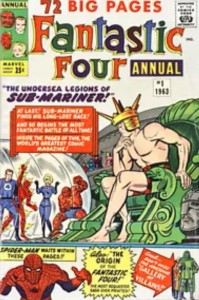 A half dozen times over the course of the next thirty issues and their first double-size annual, Namor would battle the Fantastic Four as a villain. Sometimes teaming up with their arch enemy Doctor Doom. He teamed with Hulk against the Avengers in Avengers #3, and in the very next issue, brooding over the defeat he encounters some native Eskimos worshiping a figure frozen in ice. Cursing the ignorant surface dwellers for worshiping idols, he throws the block into the North Atlantic where it drifts down to New York where the Avengers thaw out the second WWII hero, Captain America. He even was approached by Magneto recruiting mutants for his brotherhood in X-Men #6 where Charles Xavier proved he was a hybrid rather than a mutant and thus had no skin in the game. Namor would be a villain in the Marvel Universe until 1965 when he would be redeemed.
A half dozen times over the course of the next thirty issues and their first double-size annual, Namor would battle the Fantastic Four as a villain. Sometimes teaming up with their arch enemy Doctor Doom. He teamed with Hulk against the Avengers in Avengers #3, and in the very next issue, brooding over the defeat he encounters some native Eskimos worshiping a figure frozen in ice. Cursing the ignorant surface dwellers for worshiping idols, he throws the block into the North Atlantic where it drifts down to New York where the Avengers thaw out the second WWII hero, Captain America. He even was approached by Magneto recruiting mutants for his brotherhood in X-Men #6 where Charles Xavier proved he was a hybrid rather than a mutant and thus had no skin in the game. Namor would be a villain in the Marvel Universe until 1965 when he would be redeemed.
Prince Once More
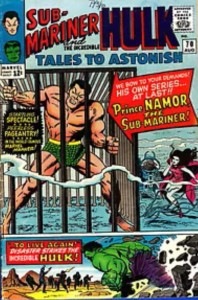 In 1965 after a long run of Ant-Man turned Giantman in Marvel’s Tales to Astonish, Marvel retired Hank Pym from his own series, kicking him back to the pages of Avengers where he would remain a regular. In his place, Marvel gave Namor his own series, sharing half the book with the Incredible Hulk beginning with Tales to Astonish #70. There they would remain until 1968 when Marvel broke the book into its own independent comics and the Submariner after 23 years would have his own title again. (That is why two #1 issues exist. One in the Golden Age and one in the Silver.) during this tumultuous time Namor for at least a third time had to defend his throne from the evil (and bigoted Krang and/or Attuma) and rescue his blue beauty Lady Dorma from their clutches. No longer a villain nor disrespected, the Prince of Atlantis took his rightful place on the throne, protecting his own from all villains, circumstances and would be enemies of the ocean (Polluters, whale killers and bad guys beware).
In 1965 after a long run of Ant-Man turned Giantman in Marvel’s Tales to Astonish, Marvel retired Hank Pym from his own series, kicking him back to the pages of Avengers where he would remain a regular. In his place, Marvel gave Namor his own series, sharing half the book with the Incredible Hulk beginning with Tales to Astonish #70. There they would remain until 1968 when Marvel broke the book into its own independent comics and the Submariner after 23 years would have his own title again. (That is why two #1 issues exist. One in the Golden Age and one in the Silver.) during this tumultuous time Namor for at least a third time had to defend his throne from the evil (and bigoted Krang and/or Attuma) and rescue his blue beauty Lady Dorma from their clutches. No longer a villain nor disrespected, the Prince of Atlantis took his rightful place on the throne, protecting his own from all villains, circumstances and would be enemies of the ocean (Polluters, whale killers and bad guys beware).
Lost with Atlantis
Now perhaps, you can see why Namor appears to be lost in limbo. Sony currently holds rights to the Fantastic Four so his Silver Age roots are out of the mix. Marvel owns Captain America and have left the All-Winners Squad out of its history so his days as a WWII hero are out, as well as his “thawing” of Cap in the modern age. In years past when Marvel let other Hollywood studios re-write or edit their character’s origins, the results were so bad that films failed for their own incredulity. Left to Hollywood alone, the Namor story would resemble the short lived Man From Atlantis series on NBC staring Patrick Duffy as the title character. And it would have met the same mediocre fate. There is great potential here for an epic sci-fi-fantasy sweeping adventure if written and produced by the same people who brought Iron Man, Thor, Avengers, and Guardians of the Galaxy to the big screen with the same love, care and due diligence to historical detail of these beloved characters. Treat the Prince royally. But alas, like the Lee and Kirby character in 1962, Namor will walk in limbo, anonymous and oblivious to the rest of the world for a number of years to come. Technically, Marvel owns just enough rights that Namor could “cameo” in a Marvel Studio’s film, like Avengers, but he cannot be “featured” in it. Neither studio can headline him in his own film without an agreement reached between them.
Second Time Around

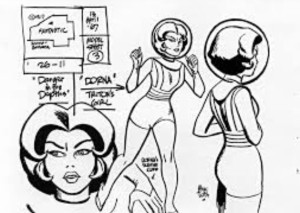
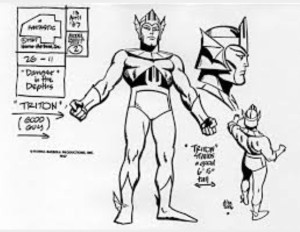
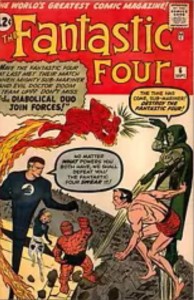
Few know that the “ownership rights” issue with Namor is actually its second round with this predicament. In 1966 Marvel leased its rights to the Fantastic Four to Hannah-Barbara studios. To date, it is the best adaptation of the FF in all media outside the comic itself. Going back to the original Lee and Kirby stories, the 1967 series is a beloved 22-episode animated series. Simultaneously, Marvel had leased animation rights to Filmation of all of its other superheroes for the Marvel Superhero Hour. Animation was not as good as Hannah-Barbara but it was totally faithful to the comics. The series literally blew up the individual original comic panels, removed word balloons and employed limited animation between panels making characters move and speak all of the original comic dialogue. For such a roughly animated series it too was beloved because it was faithful. Well. Mostly faithful. They actually got to animate the Wedding of Reed Richards and Sue Storm from the 3rd annual of the Fantastic Four. Except of course, they didn’t have the rights to the Fantastic Four. So instead, since the story involved a huge battle between every Marvel hero and villain at the Baxter Building, they altered the story. Actually they took elements of FF #6 where Sub-Mariner and Dr. Doom teamed to steal the Baxter Building, launching it Into space. The other big battles in the story was robbed from the wedding annual. In panels showing the Baxter Building a huge sign was affixed above the doorway saying, “World Trade Center.” So I guess Sub-Mariner and Dr. Doom actually were the first terrorists to do this 34 years before Islamic terrorists would bring it down. In the 30 minute Sub-Mariner animated feature the FF were drawn out of every panel. Simultaneously, over at Hannah-Barbara the story from FF #33 where Namor is restored as Prince of Atlantis, rescues Lady Dorma, defeats Attuma all with the help of the Fantastic Four is done without Namor. Instead the water breathing green-scaled Inhuman Triton is named Prince of Atlantis. But that is hardly as bad as the adaptation of FF #3 and #9, where a big grey-water monster called Gorgon replaces Namor in the story as a bad guy. H-B didn’t have the “rights” to Namor. Same ole, same ole.
Time cures all wounds

Patience might be the best virtue here. After the next big FF movie flop in 2017, Sony might sell FF rights back to Marvel. Universal who has already given over Hulk might release Namor too. A few more stars and planets aligning and we might see the first Marvel superhero movie ever to get three academy awards: Best Picture, Best Actor, Best Screenplay. Hey, with a story this rich, and liberal Hollywood on our side, it could actually happen!
